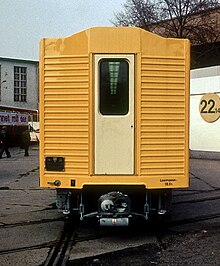Double railcar
A double multiple unit , abbreviated to DT or DTW , refers to two permanently connected multiple units on a railway . Mostly these are two firmly coupled four-axle vehicles with two bogies each . From an electrical point of view, the two halves function like a double traction , but in contrast to this, they cannot be separated from each other during operation or are generally not drivable individually. Double railcars are mirror-inverted, bidirectional vehicles , in which each half usually only has one driver's cab - which saves space and costs. Often only one part of the vehicle has a pantograph because the two cars are electrically connected to one another by the (short) coupling. Furthermore, a distinction is made between double railcars with and without a transition option between the two car bodies. In the case of double railcars with a transition, it is often no longer possible to clearly distinguish them from the articulated vehicle . If, on the other hand, the two car bodies share a common Jakobs bogie or are saddled up on top of one another, the term “double railcar” is usually no longer used.
Closely related to the double multiple units are also the twin multiple units in the tramway , which were used mainly in Hungary and are sometimes also called double multiple units . However, these consisted of two identical cars, had no transition option and were often only joined together at a later date.
Examples
railroad
- Saxon E 1 (1904)
- Wittfeld accumulator railcar (from 1909)
- DR 581/582 to 615/616 (from 1926)
- SBB RAe 4/8 1021 (1939)
- DR 137 326… 376 (from 1940)
- ČSD series M 485.0 (1943)
- 210–212 of the Cologne-Bonn Railways (1964)
- MOB ABDe 8/8 4001–4004 of the Montreux – Berner Oberland Railway (from 1968)
- Class 628.0 of the Deutsche Bundesbahn (from 1974)
- LHB VT 2E (from 1976)
- Be 8/8 21 / 22–31 / 32 of the Forchbahn (from 1976)
- MG Bhe 4/8 of the Monte Generoso Railway (from 1982)
- WAB BDhe 4/8 of the Wengernalp Railway (1988)
- Class 610 of the Deutsche Bundesbahn (from 1992)
- Class 5147 of the Austrian Federal Railways (from 1992)
- Class 628.9 / 629 of the Deutsche Bahn (from 1994)
- Class 611 of the Deutsche Bahn (from 1996)
- Class 612 of Deutsche Bahn (from 1998)
Train
- BVG class 480 of the S-Bahn Berlin (from 1986)
Subway
- BVG series D of the Berlin U-Bahn (from 1956)
- HHA type DT1 of the Hamburg subway (from 1958)
- BVG series A3 of the Berlin U-Bahn (from 1960)
- HHA type DT2 of the Hamburg subway (from 1962)
- HHA type DT3 of the Hamburg subway (from 1966)
- MVG series A of the Munich subway (from 1967)
- VAG series DT1 of the Nuremberg subway (from 1970)
- Railcar U of the Vienna U-Bahn (from 1972)
- BVG series F of the Berlin U-Bahn (from 1973)
- BVG series G of the Berlin U-Bahn (from 1974); Double railcar with only one driver's cab
- MVG series B of the Munich subway (from 1981)
- HHA type DT4 of the Hamburg subway (from 1988)
- VAG series DT2 of the Nuremberg subway (from 1993)
- VAG series DT3 of the Nuremberg subway (from 2004)
Light rail
- SSB DT 8 of the Stuttgart Stadtbahn (from 1981)
See also
- Train formation # railcar
- SSB DoT4 of the Stuttgart trams , also known as a double multiple unit, four-axle articulated car made up of three car parts, from 1964 put together from two older two-axle single cars and a free-floating sedan chair
- Trolleybus double traction




